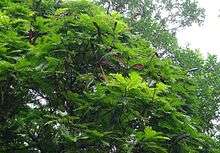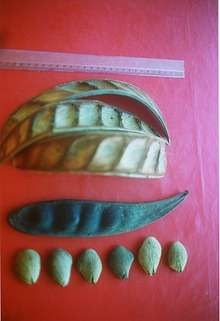Pentaclethra macroloba
Pentaclethra macroloba is a tree in the genus Pentaclethra native to the wet tropical areas of the northern Neotropics.
| Pentaclethra macroloba | |
|---|---|
 | |
| Pentaclethra macroloba tree in Costa Rica | |
| Scientific classification | |
| Kingdom: | |
| (unranked): | |
| (unranked): | |
| (unranked): | |
| Order: | |
| Family: | |
| Subfamily: | |
| (unranked): | |
| Genus: | |
| Species: | P. macroloba |
| Binomial name | |
| Pentaclethra macroloba | |
| Synonyms[2] | |
|
Acacia macroloba Willd. | |
Description
Pentaclethra macroloba is a canopy tree which reaches heights of 30–35 metres (98–115 ft) and a trunk diameter of 130 centimetres (51 in). Leaves are twice compound, arranged in a spiral on the stems. The leaf blades, which can be up to 30 centimetres (12 in) long, consist of 15 to 20 paired leaflets 2–10 centimetres (1–4 in) long.[2]
Flowers are small, with purple petals (4–5 millimetres (0.16–0.20 in) long) becoming greenish towards their tips. Inflorescences are racemes; despite producing about 200 flowers per inflorescence, each one produces only a few fruit.[2]
Distribution
The species ranges from Nicaragua to the Amazon basin and exists in three distinct populations. One population ranges from the Amazon, through Venezuela and the Guianas, to Trinidad and Tobago. The second population occurs in western Colombia and Darien Province in Panama. The third is found in western Panama, Costa Rica and Nicaragua. It grows in lowland forest from sea level to 600 m above sea level, and is especially abundant in wetter areas.[2]
Ecology
Seeds are mechanically dispersed when mature pods split. Submerged seeds developed air pockets that allowed them to float; this has been interpreted as evidence that the species has adaptions for dispersal by water (hydrochory).[3][4]
Like many leguminous plants, P. macroloba is a nitrogen fixer which forms a symbiotic relationship with Rhizobium, which grows in specialised root nodules. While root nodules are typically found on buried roots, P. macroloba individuals growing in swampy areas produce nodules on aerial roots.[5]
Uses
Timber
The sapwood of the tree is whitish, drying to pink, while the heartwood is reddish brown. The timber has a specific gravity of 0.51–0.61 and is used to make furniture, cabinets and for general construction.[2]
Oil
Pracaxi oil, which is extracted from the seeds of P. macroloba, is rich in oleic, linoleic, and behenic acid, and is used medicinally by indigenous Amazonian populations.[6][7] It is used as a replacement for synthetic hair conditioners in 'green' cosmetics.[8]

References
- The Legume Phylogeny Working Group (LPWG). (2017). "A new subfamily classification of the Leguminosae based on a taxonomically comprehensive phylogeny". Taxon. 66 (1): 44–77. doi:10.12705/661.3.
- Flores, E. M. (2002). "Pentaclethra macroloba" (PDF). In J. A. Vozzo (ed.). Tropical Tree Seed Manual. Agricultural Handbook. 721. Washington, DC: USDA Forest Service. pp. 601–604.
- Williamson, G. Bruce; Costa, Flavia (2000). "Dispersal of Amazonian Trees: Hydrochory in Pentaclethra macroloba". Biotropica. 32 (3): 548–552. doi:10.1111/j.1744-7429.2000.tb00501.x. JSTOR 2663887.
- Lopez, O. R. (2001). "Seed flotation and postflooding germination in tropical terra firme and seasonally flooded forest species". Functional Ecology. 15 (6): 763–771. doi:10.1046/j.0269-8463.2001.00586.x.
- Walter, Cynthia A.; Bien, Amos (1989). "Aerial Root Nodules in the Tropical Legume, Pentaclethra macroloba". Oecologia. 80 (1): 27–31. doi:10.1007/bf00789927. JSTOR 4219004. PMID 23494341.
- Banov, Daniel; Banov, Fabiana; Bassani, August S. (2014). "Case Series: The Effectiveness of Fatty Acids from Pracaxi Oil in a Topical Silicone Base for Scar and Wound Therapy". Dermatology and Therapy. 4 (2): 259–269. doi:10.1007/s13555-014-0065-y. PMC 4257951. PMID 25410612.
- dos Santos Costa, Marina Nídia Ferreira; Muniz, Marcos Antônio Pena; Negrão, Charles Alberto Brito; da Costa, Carlos Emmerson Ferreira; Lamarão, Maria Louze Nobre; Morais, Luiz; Silva Júnior, José Otávio Carréra; Costa, Roseane Maria Ribeiro (2014). "Characterization of Pentaclethra macroloba oil: Thermal stability, gas chromatography and Rancimat". Journal of Thermal Analysis and Calorimetry. 115 (3): 2269–2275. doi:10.1007/s10973-012-2896-z.
- Beerling, Judi (2013). "Green Formulations and Ingredients". In Amarjit Sahota (ed.). Sustainability : How the Cosmetics Industry Is Greening Up. John Wiley & Sons. pp. 197–216. ISBN 9781119945543.
| Wikimedia Commons has media related to Pentaclethra macroloba. |